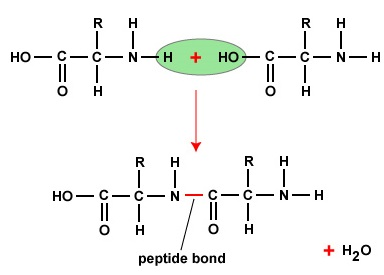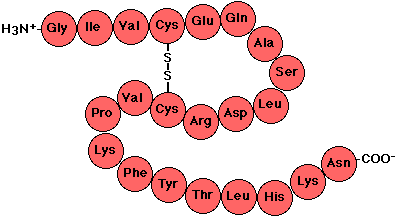Elementary idea of α – amino acids, peptide bond, polypeptides, proteins
Proteins are the linear polymers, which are formed by the linking of the alpha carboxyl group of amino acid, to the alpha-amino group of another amino acid by the amide bond, also known as the peptide bond. The combining of two amino acids, to form the dipeptide, is accompanied by the loss of one molecule of water. Equilibrium of this reaction depends on the side of hydrolysis but not on the synthesis. So, an input of free energy is required for the biosynthesis of the peptide bonds. Kinetically, these peptide bonds are quite stable, and in the aqueous solution, in the absence of catalyst the lifetime of the peptide bond, approaches about 1000 years.
Alpha-amino acid is a generally used term in biochemistry and which have an R group as an organic substituent. The carboxylate and amino groups in the alpha-amino acids are attached to the same carbon that is the alpha carbon. Different alpha-amino acids vary, in terms of R groups or side chains, which are attached to the alpha carbon. Their size is different and it greatly varies from an atom of hydrogen in the glycine, through the methyl group present in the alanine and to the large heterocyclic group in the tryptophan. These alpha-amino acids are the building blocks of the proteins. Protein is formed by the condensation of amino acids and a chain of amino acid residues is formed that is linked by the peptide bonds. The unique sequence of amino acid residues defines the structure of proteins.

A peptide bond is formed between the two molecules when there is a reaction between the carboxyl group of one molecule, and the amino group of another molecule and as a result of this reaction a water molecule is released. Usually, this reaction occurs between the amino acids and it is a dehydration synthesis reaction. Chains of the amino acids make the polypeptides and the combining of polypeptide molecules causes the formation of proteins. A free amino group is present on the N terminal of the polypeptide. On the other end, there is a free carboxyl group that is known as C-terminal. In the polypeptides, the sequence of amino acids is directed by the codons.

Proteins are complex molecules, made up of small molecules of amino acids by the bond linking that is known as the peptide bond and this peptide can be dipeptide, tripeptide, and polypeptide.